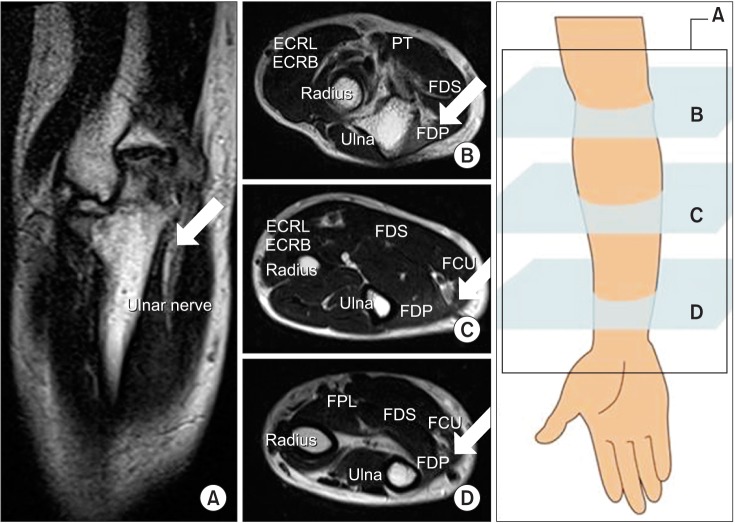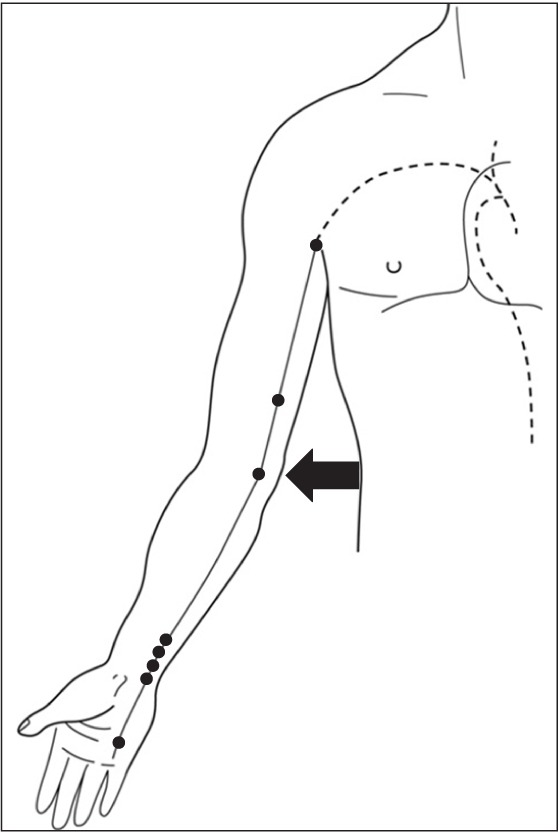Ann Rehabil Med.
2017 Jun;41(3):483-487. 10.5535/arm.2017.41.3.483.
Severe Ulnar Nerve Injury After Bee Venom Acupuncture at a Traditional Korean Medicine Clinic: A Case Report
- Affiliations
-
- 1Department of Rehabilitation Medicine, Gangnam Severance Hospital, Seoul, Korea. RMPJH@yuhs.ac
- 2Rehabilitation Institute of Neuromuscular Disease, Yonsei University College of Medicine, Seoul, Korea.
- KMID: 2389465
- DOI: http://doi.org/10.5535/arm.2017.41.3.483
Abstract
- This case report describes a severe nerve injury to the right ulnar nerve, caused by bee venom acupuncture. A 52-year-old right-handed man received bee venom acupuncture on the medial side of his right elbow and forearm, at a Traditional Korean Medicine (TKM) clinic. Immediately after acupuncture, the patient experienced pain and swelling on the right elbow. There was further development of weakness of the right little finger, and sensory changes on the ulnar dermatome of the right hand. The patient visited our clinic 7 days after acupuncture. Electrodiagnostic studies 2 weeks after the acupuncture showed ulnar nerve damage. The patient underwent steroid pulse and rehabilitation treatments. However, his condition did not improve completely, even 4 months after acupuncture.
MeSH Terms
Figure
Reference
-
1. Korea Institute of Oriental Medicine. A survey on the use of traditional Korean medicine, 2008. Seoul: Ministry of Health and Welfare;2009.2. Lee JD, Park HJ, Chae Y, Lim S. An overview of bee venom acupuncture in the treatment of arthritis. Evid Based Complement Alternat Med. 2005; 2:79–84. PMID: 15841281.
Article3. Chen J, Lariviere WR. The nociceptive and anti-nociceptive effects of bee venom injection and therapy: a double-edged sword. Prog Neurobiol. 2010; 92:151–183. PMID: 20558236.
Article4. Schroeder S, Meyer-Hamme G, Zhang J, Epplee S, Friedemann T, Hu W. An acupuncture research protocol developed from historical writings by mathematical reflections: a rational individualized acupoint selection method for immediate pain relief. Evid Based Complement Alternat Med. 2013; 2013:256754. PMID: 23431334.
Article5. White A. A cumulative review of the range and incidence of significant adverse events associated with acupuncture. Acupunct Med. 2004; 22:122–133. PMID: 15551936.
Article6. World Health Organization. The regional strategy for traditional medicine in the Western Pacific (2011–2020). Manila: World Health Organization, Regional Office for the Western Pacific;2002.7. Korea Ministry of Health and Welfare. A survey on the use of traditional Korean medicine and herbal medicine. Seoul: Ministry of Health and Welfare;2011.8. Ha SY, Kang KW. Two cases of lead poisoning after taking herb pills, Hwangdan (Red Lead). J Korean Pediatr Soc. 1979; 22:64–70.9. Kim Y, Kim Y, Lee H. The clinical study on 6 cases of patients with side effect caused by acupuncture therapy. J Daejeon Univ Tradit Korean Med Inst. 2006; 15:47–52.




